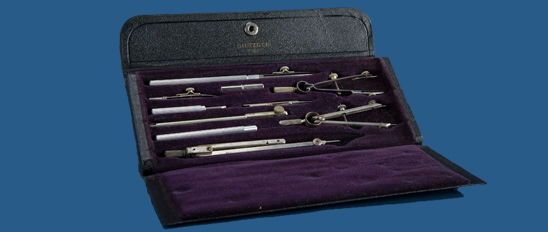This wooden case is covered with black leather, has metal latches, and is lined with purple velvet. A purple satin ribbon inside the lid is marked: FROST & ADAMS, (/) BOSTON, MASS.
- Description
-
This wooden case is covered with black leather, has metal latches, and is lined with purple velvet. A purple satin ribbon inside the lid is marked: FROST & ADAMS, (/) BOSTON, MASS. The set contains the following instruments, all of which fit properly in their slots and thus may be original:
-
1) 6-1/4" German silver drawing compass with reversible needle point, removable pencil point, pen point attachment, and extension bar with pencil point. The insides of the compass legs are marked: FROST & ADAMS BOSTON, MASS. Each leg is also marked: QA. The insert for the pencil point is marked: QA. The inserts for the pen point and extension bar are marked: QG.
-
2) 6-1/4" German silver and steel fixed-leg dividers. The insides of the divider legs are marked: BOSTON, MASS. FROST & ADAMS. Each leg is also marked: 43.
-
3) 2" metal cylinder with three pencil leads and two needle points.
-
4) Three German silver and steel drawing pens with wooden handles (4-1/4", 5", 4-7/8"). The 4-7/8" pen has a metal lever marked: PAT.MAR.26.89.
-
5) 3-1/4" German silver and steel bow pencil, bow dividers, and bow pen. Each instrument is marked on the side: F A.
-
George Bennett, a resident of Philadelphia who had emigrated from England, received at least two patents for drawing pens. The first, for a pen that could make both narrow and broad lines at once so that a draftsman did not have to adjust the nib and add the broad lines later, is listed on a pen in this set.
-
Francis Seth Frost and E. H. Adams purchased an artists' supply store from Matthew J. Whipple at 37 Cornhill Street in Boston in 1867. Frost bought out Adams in 1872 but kept the Frost & Adams name. He expanded the business into additional locations, employed traveling salesmen, and stocked architectural materials and decorative items. Frost & Adams retailed sets of drafting instruments made by Kern and by Alteneder, but this particular set was not advertised in the firm's catalogs for 1890, 1912, 1914, or 1915. The H. H. Sullivan Company purchased the store in the 1920s and was subsequently acquired by B. L. Makepeace in 1931.
-
References: George Bennett, "Drawing Pen" (U.S. Patent 400,178 issued March 26, 1889), and "Drafting Pen" (U.S. Patent 1,099,160 issued June 9, 1914); Moses King Corporation, King's Handbook of Boston (Buffalo, N.Y., 1889), 361–362.
- Location
-
Currently not on view
- date made
-
1889-1921
- ID Number
-
MA.325682
- accession number
-
257193
- catalog number
-
325682
